
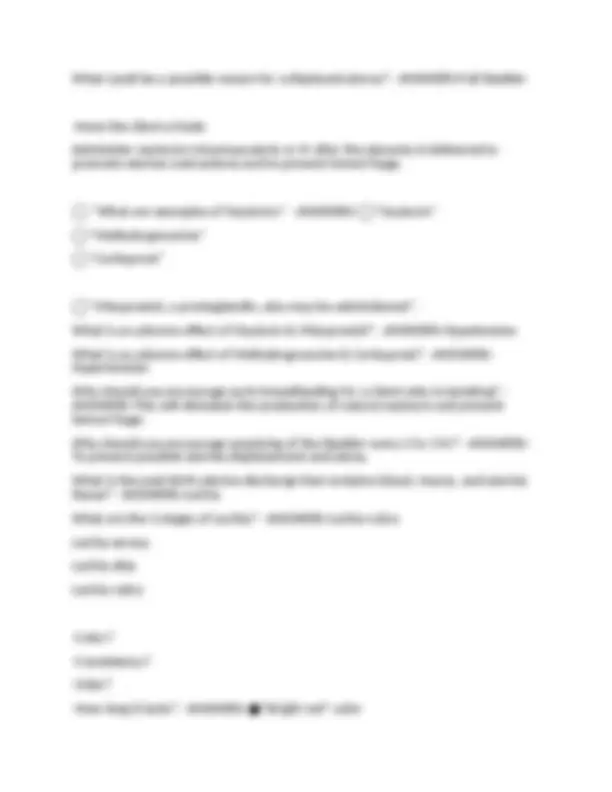
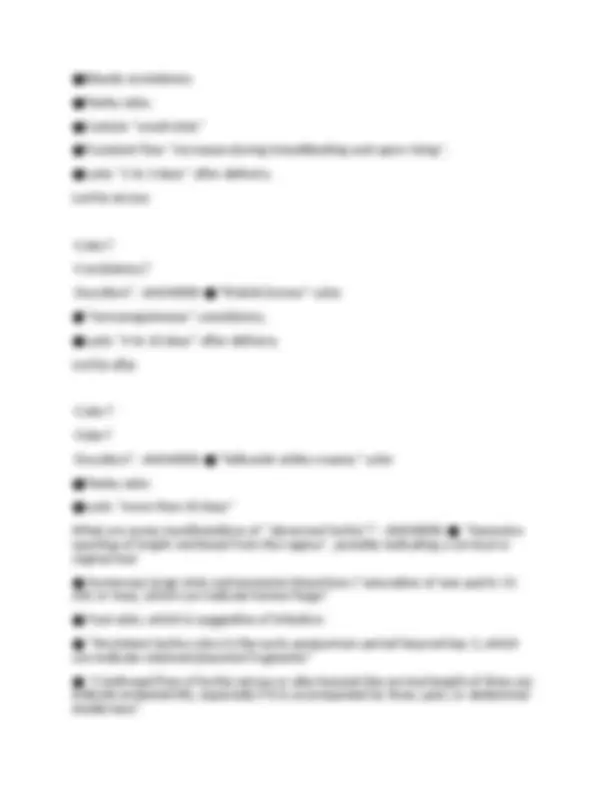
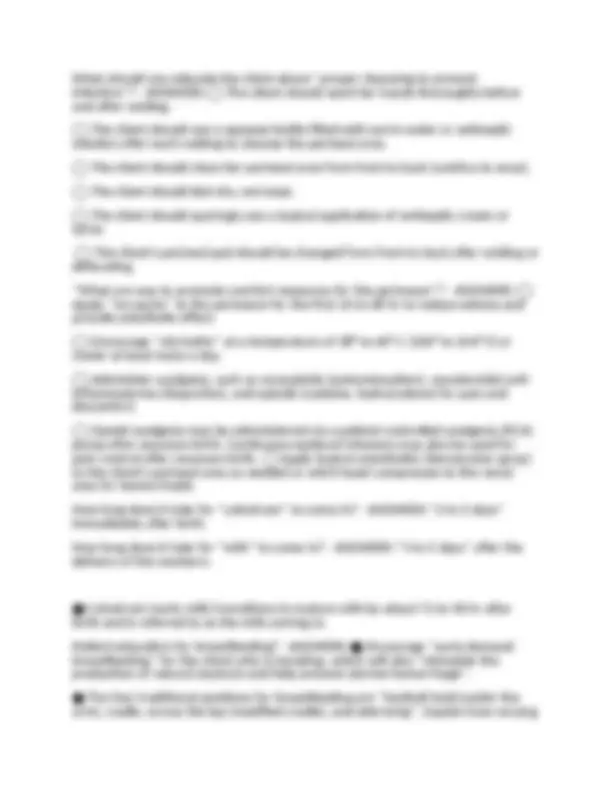
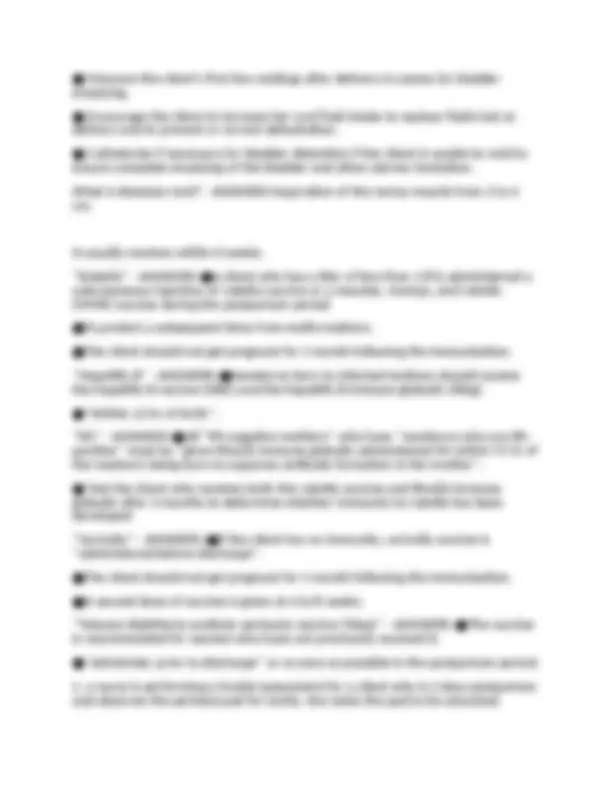
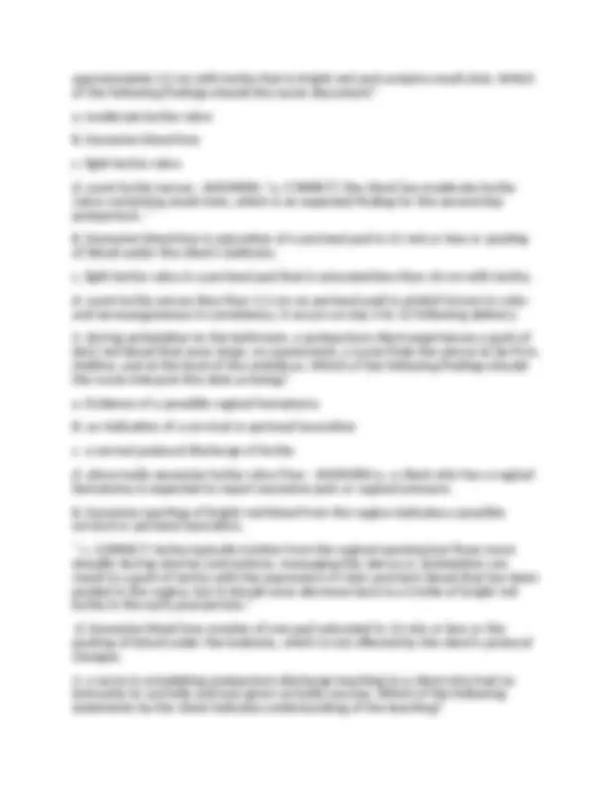
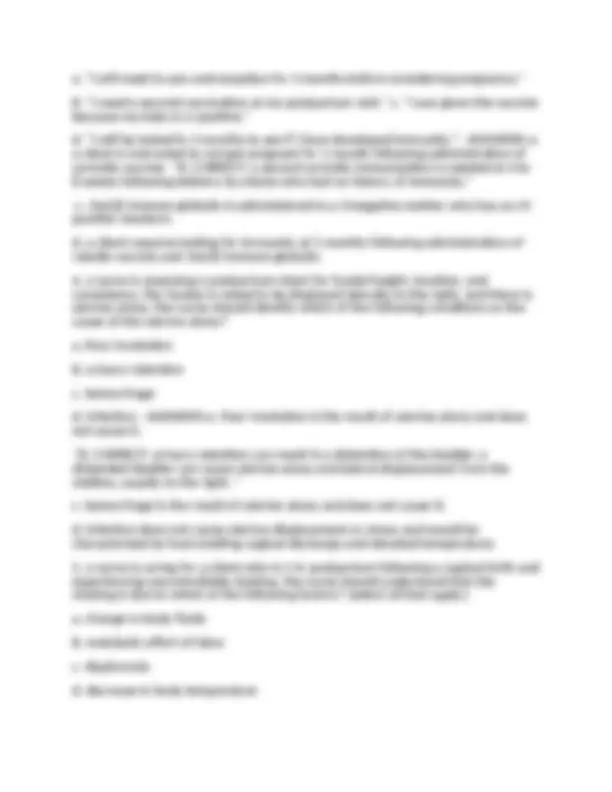


Study with the several resources on Docsity

Earn points by helping other students or get them with a premium plan


Prepare for your exams
Study with the several resources on Docsity

Earn points to download
Earn points by helping other students or get them with a premium plan
Community
Ask the community for help and clear up your study doubts
Discover the best universities in your country according to Docsity users
Free resources
Download our free guides on studying techniques, anxiety management strategies, and thesis advice from Docsity tutors
Postpartum Physiological Adaptations (ch. 17 ATI, ch. 20 Maternity textbook) Questions With Complete Solutions 2025 Graded A+. Postpartum Physiological Adaptations (ch. 17 ATI, ch. 20 Maternity textbook) Questions With Complete Solutions 2025 Graded A+.
Typology: Exams
1 / 11

This page cannot be seen from the preview
Don't miss anything!







What is the main goal during the immediate postpartum period? - ANSWERS-To prevent postpartum hemorrhage How long is the postpartum period, also known as the puerperium? - ANSWERS- around 6 weeks What are the greatest risks during the postpartum period? - ANSWERS- hemorrhage, shock, and infection Oxytocin, a hormone released from the pituitary gland, coordinates and strengthens uterine contractions. What are two ways to receive oxytocin? - ANSWERS-◯ Breastfeeding stimulates the release of endogenous oxytocin from the pituitary gland. ◯ Exogenous oxytocin can be administered postpartum to improve the quality of the uterine contractions. What state should the uterus be in to prevent excessive bleeding and hemorrhage? - ANSWERS-A firm and contracted uterus Uncomfortable uterine cramping is referred to as? - ANSWERS-Afterpains postpartum physical assessment should include assessing the client's BUBBLE What does it stand for? - ANSWERS-● B: Breasts ● U: Uterus (fundal height, uterine placement, and consistency) ● B: Bowel and GI function ● B: Bladder function ● L: Lochia (color, odor, consistency, and amount [COCA]) ● E: Episiotomy (edema, ecchymosis, approximation) When & why is RhoGAM given? - ANSWERS--Rho(D) immune globulin is administered within 72 hr to women who are Rh-negative and gave birth to infants who are Rh-positive -To prevent sensitization in future pregnancies What does the Kleihauer-Betke test determine? - ANSWERS-*The Kleihauer-
Betke test determines the amount of fetal blood in maternal circulation if a large fetomaternal transfusion is suspected. If 15 mL or more of fetal blood is detected, the mother should receive an increased Rho(D) immune globulin dose. What do postpartum women typically experience during the first 2 hours after birth? - ANSWERS-Postpartum chill* This is a normal occurrence unless accompanied by an elevated temperature. ● Provide warm blankets and fluids. ● Assure client that these chills are a self-limiting, common occurrence that will last only a short while. Fundal height - ANSWERS-● Immediately after delivery -fundus should be firm; at level w/ umbilicus. ●At 12 hr postpartum -the fundus is 1 cm above the umbilicus. ● Every 24 hr -the fundus willdescend 1 to 2 cm. ●It should be halfway between the symphysis pubis and the umbilicus by the sixth postpartum day. ● After 2 weeks -the uterus should lie within the true pelvis and should not be palpable How often should a nurse should assess the fundal height, uterine placement, and uterine consistency? - ANSWERS-At least every 8 hr after the recovery period has ended. How to locate the Fundus? - ANSWERS-Cup one hand just above the symphysis pubis to support the lower segment of the uterus, and with the other hand, palpate the abdomen to locate the fundus. What should you do if the fundus is boggy? - ANSWERS-lightly massage the fundus in a circular motion
●Bloody consistency ●Fleshy odor, ●Contain small clots ●Transient flow increases during breastfeeding and upon rising. ●Lasts 1 to 3 days after delivery. Lochia serosa -Color? -Consistency? -Duration? - ANSWERS-●Pinkish brown color ●Serosanguineous consistency. ●Lasts 4 to 10 days after delivery. Lochia alba -Color? -Odor? -Duration? - ANSWERS-●Yellowish white creamy color ●Fleshy odor. ●Lasts more than 10 days What are some manifestations of abnormal lochia? - ANSWERS-● Excessive spurting of bright red blood from the vagina, possibly indicating a cervical or vaginal tear ● Numerous large clots and excessive blood loss (saturation of one pad in 15 min or less), which can indicate hemorrhage ● Foul odor, which is suggestive of infection ● Persistent lochia rubra in the early postpartum period beyond day 3, which can indicate retained placental fragments ● Continued flow of lochia serosa or alba beyond the normal length of time can indicate endometritis, especially if it is accompanied by fever, pain, or abdominal tenderness
What should you educate the client about proper cleansing to prevent infection? - ANSWERS-◯ The client should wash her hands thoroughly before and after voiding. ◯ The client should use a squeeze bottle filled with warm water or antiseptic solution after each voiding to cleanse the perineal area. ◯ The client should clean her perineal area from front to back (urethra to anus). ◯ The client should blot dry, not wipe. ◯ The client should sparingly use a topical application of antiseptic cream or spray. ◯ The client's perineal pad should be changed from front to back after voiding or defecating. What are way to promote comfort measures for the perineum? - ANSWERS-◯ Apply ice packs to the perineum for the first 24 to 48 hr to reduce edema and provide anesthetic effect. ◯ Encourage sitz baths at a temperature of 38° to 40° C (100° to 104° F) or cooler at least twice a day. ◯ Administer analgesia, such as nonopioids (acetaminophen), nonsteroidal anti- inflammatories (ibuprofen), and opioids (codeine, hydrocodone) for pain and discomfort. ◯ Opioid analgesia may be administered via a patient-controlled analgesia (PCA) pump after cesarean birth. Continuous epidural infusions may also be used for pain control after cesarean birth. ◯ Apply topical anesthetics (benzocaine spray) to the client's perineal area as needed or witch hazel compresses to the rectal area for hemorrhoids How long does it take for colostrum to come in? - ANSWERS-2 to 3 days immediately after birth. How long does it take for milk to come in? - ANSWERS-3 to 5 days after the delivery of the newborn. ● Colostrum (early milk) transitions to mature milk by about 72 to 96 hr after birth and is referred to as the milk coming in. Patient education for breastfeeding? - ANSWERS-● Encourage early demand breastfeeding for the client who is lactating, which will also stimulate the production of natural oxytocin and help prevent uterine hemorrhage. ● The four traditional positions for breastfeeding are football hold (under the arm), cradle, across the lap (modified cradle), and side-lying. Explain how varying
hemorrhoids. ● Assess the rectal area for varicosities (hemorrhoids). ● Operative vaginal birth (forceps-and vacuum-assisted) and anal sphincter lacerations increase the risk of temporary postpartum anal incontinence that usually resolves within 6 months. What nursing actions can be performed to treat constipation & promote proper bowel function? - ANSWERS-● Encourage the client to do early ambulation, increased fluids, and high-fiber food sources ● Administer stool softeners (docusate sodium) to prevent constipation. ● Enemas and suppositories are contraindicated for clients who have third- or fourth-degree perineal lacerations. A distended bladder as a result of urinary retention can cause what? - ANSWERS-Uterine atony and displacement to one side, usually to the right. The ability of the uterus to contract is also lessened. Have the woman void! What should the nurse assess for in terms of the client's urinary/bladder function?
● Measure the client's first few voidings after delivery to assess for bladder emptying. ● Encourage the client to increase her oral fluid intake to replace fluids lost at delivery and to prevent or correct dehydration. ● Catheterize if necessary for bladder distention if the client is unable to void to ensure complete emptying of the bladder and allow uterine involution. What is diastasis recti? - ANSWERS-Separation of the rectus muscle from 2 to 4 cm. It usually resolves within 6 weeks. Rubella - ANSWERS-●A client who has a titer of less than 1:8 is administered a subcutaneous injection of rubella vaccine or a measles, mumps, and rubella (MMR) vaccine during the postpartum period ●To protect a subsequent fetus from malformations. ●The client should not get pregnant for 1 month following the immunization. Hepatitis B - ANSWERS-●Newborns born to infected mothers should receive the hepatitis B vaccine (HBV) and the hepatitis B immune globulin (Hbig) ●Within 12 hr of birth. Rh - ANSWERS-●All Rh-negative mothers who have newborns who are Rh- positive must be given Rho(D) immune globulin administered IM within 72 hr of the newborn being born to suppress antibody formation in the mother. ● Test the client who receives both the rubella vaccine and Rho(D) immune globulin after 3 months to determine whether immunity to rubella has been developed Varicella - ANSWERS-●If the client has no immunity, varicella vaccine is administered before discharge. ●The client should not get pregnant for 1 month following the immunization. ●A second dose of vaccine is given at 4 to 8 weeks. Tetanus-diphtheria-acellular pertussis vaccine (Tdap) - ANSWERS-●The vaccine is recommended for women who have not previously received it. ●Administer prior to discharge or as soon as possible in the postpartum period.
a. "i will need to use contraception for 3 months before considering pregnancy." B. "i need a second vaccination at my postpartum visit." c. "i was given the vaccine because my baby is o-positive." d. "i will be tested in 3 months to see if i have developed immunity." - ANSWERS-a. a client is instructed to not get pregnant for 1 month following administration of varicella vaccine. B. CORRECT: a second varicella immunization is needed at 4 to 8 weeks following delivery by clients who had no history of immunity. c. rho(d) immune globulin is administered to a rhnegative mother who has an rh- positive newborn. d. a client requires testing for immunity at 3 months following administration of rubella vaccine and rho(d) immune globulin.
E. decrease in prolactin levels - ANSWERS-*a. CORRECT: a shift in body fluids during the first 2 hr puerperium can cause a postpartum chill. * B. CORRECT: the work of labor can cause a postpartum chill during the first 2 hr puerperium. c. diaphoresis is the mechanism by which the excess fluid of pregnancy is removed from the body. it usually occurs within the first 2 to 3 days following delivery. d. an increase in body temperature is associated with a postpartum chill, but it is not the cause of it. E. changes in prolactin levels affect ovulation and menses and are not the cause of a postpartum chill.